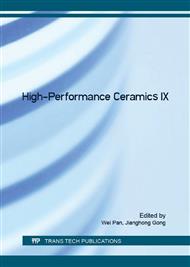p.472
p.476
p.481
p.485
p.489
p.494
p.498
p.506
p.510
Preparation and Properties of SiC/Si-B-C-N Ceramic Composites
Abstract:
Abstract:SiC/Si-B-C-N and SiC/SiC ceramic matrix composites were prepared through a combination of chemical vapor infiltration (CVI) and polymer impregnation pyrolysis process(PIP). The microscopic morphology and solid phase structure of the SiC/Si-B-C-N and SiC/SiC composites were investigated by SEM and XRD respectively. Moreover,the flexural strength and fracture toughness were measured using three point bending and single-edge notched beam test. Results showed that the formation of crystalline phases transformation was restrained by introduce BN into matrix phase, which might improve the stability of ceramic matrix composites. Furthermore, the flexural strength and fracture toughness of ceramic matrix composites increased to a maximum of 367 MPa and 26.81 MPa·m1/2 with the 30% PBN weight ratios which might be mainly caused by crack arresting, crack deflecting, micro cracks and fiber pullout.
Info:
Periodical:
Pages:
489-493
Citation:
Online since:
July 2016
Authors:
Price:
Сopyright:
© 2016 Trans Tech Publications Ltd. All Rights Reserved
Share:
Citation:


